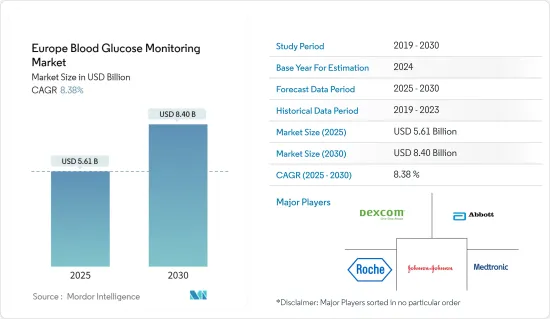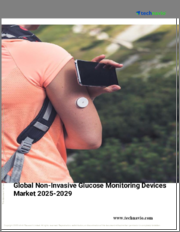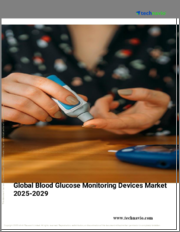
|
시장보고서
상품코드
1687203
유럽의 혈당 모니터링 시장 : 시장 점유율 분석, 산업 동향 및 통계, 성장 예측(2025-2030년)Europe Blood Glucose Monitoring - Market Share Analysis, Industry Trends & Statistics, Growth Forecasts (2025 - 2030) |
||||||
유럽의 혈당 모니터링 시장 규모는 2025년에 56억 1,000만 달러로 추정되고, 예측 기간인 2025-2030년 CAGR 8.38%로 성장할 전망이며, 2030년에는 84억 달러에 달할 것으로 예측됩니다.

COVID-19의 대유행은 혈당 모니터링 시장에 큰 영향을 주었습니다. 제1형 당뇨병 환자는 COVID-19의 사이에 보다 많은 영향을 받고 있습니다. 당뇨병 환자는 면역계가 약하기 때문에 COVID-19에서는 면역계가 급속하게 약해집니다. 당뇨병 환자는 보통 사람보다 심각한 합병증을 일으킬 가능성이 높아집니다.
당뇨병 범주에 따르면, 유럽에서 COVID-19의 1파에서 입원 1건당 추정 비용은 혈당 조절이 양호한 2형 당뇨병 환자의 25,018유로에서 혈당 조절이 불량한 1형 당뇨병 환자의 5만 7,244유로의 범위로, 집중 치료, 사람 공호흡기 지지, 입원기간 연장의 위험이 높음을 반영했습니다. 당뇨병이 없는 환자의 추정 비용은 1만 6,993유로였습니다. 유럽의 코로나19 2차 의료에 예상되는 직접 지출 총액은 139억 유로였습니다. 당뇨병 치료는 총 지출의 23.5%를 차지했습니다.
유럽 국가들은 당뇨병으로 인한 고액 지출 부담으로 고통받고 있습니다. IDF에 따르면 유럽에서 20-79세 인구의 당뇨병 전체 지출은 1,560억 달러로 2040년까지 1,740억 달러로 증가할 것으로 예상됩니다. IDF의 다른 통계에 따르면 매년 21,600명의 유아가 1형 당뇨병 환자로 추가되고 있습니다. 이 수치는 유럽에서는 총 의료 지출의 약 9%가 당뇨병에 소비되고 있음을 보여줍니다.
기술이 발전함에 따라 혈당 모니터링기는 셀룰러 연결 유형으로 진화했습니다. 이러한 장비는 자체 혈당 모니터링(SMBG) 데이터를 안전한 클라우드 기반 데이터베이스에 자동으로 업로드합니다. 이로 인해 SMBG 데이터 공유 및 모니터링이 개선되었습니다. SMBG 데이터의 실시간 모니터링은 SMBG 기록에 이상이 있는 환자에게 적시에 지원을 제공할 수 있는 기회를 설명합니다.
이러한 기술적 진보를 이용한 당뇨병 원격 모니터링 프로그램은 통제 불량의 당뇨병 환자에게 추가 지원을 제공할 수 있습니다. 이 지원은 중요한 결과를 크게 개선하고 향후 시장 전망을 높일 수 있습니다.
인슐린 펌프 또는 하루에 여러 번 주사(MDI) 요법에 의존하는 환자에게 CGM은 심각한 저혈당 위험을 집계하지 않고 혈당 균형을 개선하는 데 도움이 되는 효과적인 도구입니다.
따라서 앞서 언급한 요인에 따라 이 시장은 분석 기간 동안 성장할 것으로 예상됩니다.
유럽의 혈당 모니터링 시장 동향
연속 혈당 모니터링은 유럽 혈당 모니터링 시장에서 최고 시장 점유율을 유지
CGM은 설정된 간격으로 혈당 수준을 확인하는 기존의 루틴에서 달성할 수 있는 것보다 혈당 수준의 패턴과 동향의 더 상세한 이미지를 제공하는 데 사용됩니다. 현재의 CGM 장비는 데이터를 다운로드함으로써 혈당의 동향을 소급적으로 표시하거나 또는 수신기 디스플레이를 통해 혈당 수준의 실시간 이미지를 제공할 수 있습니다.
대부분의 실시간 CGM은 혈당의 적시 관리를 촉진하기 위해 실제 또는 보류중인 혈당 방문 중에 환자, 부모 또는 간병인에게 경고를 발행할 수 있습니다. 이러한 요인과 휴대폰과의 통합과 같은 신기술의 출현으로 CGM 디바이스가 저렴해지고 있다는 사실로 인해 CGM 시장은 예측 기간 동안 꾸준한 성장세를 보일 것으로 예상됩니다.
현재의 CGM 장치는 설정된 간격으로 혈당 수준을 정기적으로 확인하는 것에 비해 혈당의 패턴이나 경향을 상세하게 표시합니다. 이러한 기술은 손가락을 통한 자가혈당모니터링(SMBG)의 많은 한계를 극복하고 당뇨병의 혈당 조절을 체크하기 위해 HbA1c를 초과할 수 있게 합니다. 게다가 현재 지속혈당 모니터링 장치는 데이터를 다운로드함으로써 혈당의 동향을 소급적으로 표시하거나 수신기 디스플레이를 통해 실시간으로 혈당 수준을 표시할 수 있습니다.
연속 혈당 모니터링(CGM) 센서는 개별 환자의 치료 계획의 효과를 오프라인으로 평가하는 새로운 시나리오를 열어 저/고혈당 경보 시스템 및 인공 췌장의 폐루프 제어 알고리즘과 같은 혁신적인 온라인 애플리케이션 개발을 자극했습니다.
2022년 6월, 웨어러블 당뇨병 기술의 리더인 Cequr는 최신의 혁신적인 인슐린 전달 장치인 인슐린 펜 2.0TM을 발표했습니다. 이 펜은 사용자의 몸에 항상 장착할 수 있을 정도로 소형이고 혈당 모니터링기도 내장돼 있어 사용자는 하루 종일 혈당을 추적할 수 있습니다.
당뇨병에 대한 국민의식의 고조는 당뇨병의 예후 및 진단 치료를 이유로 SMBG와 CGM 모두의 채용을 촉진할 것으로 예상됩니다.
독일은 유럽의 혈당 모니터링 시장을 독점할 것으로 예상됩니다.
2022년 독일은 유럽 시장의 31.87%를 차지했습니다. 독일 당뇨병 센터(DDZ)에 따르면 현재 독일에서는 인구의 적어도 7.2%가 당뇨병을 앓고 있으며, 향후 20년간 크게 증가할 전망입니다. 독일의 성인 인구에서 알려진 1형 당뇨병과 2형 당뇨병의 유병률은 매우 높고, 아직 당뇨병으로 진단되지 않은 환자도 많습니다. 고령화와 건강하지 못한 라이프 스타일로 인해 제2형 당뇨병의 유병률은 향후 몇 년간 확실히 증가할 것으로 예상되고 있습니다.
COVID-19 기간 중 후생성은 독일이 4억 유로로 20만 회분의 실험적 항체 칵테일을 구입해 대학병원에서 투여하고 질병의 초기 단계에 있는 고위험의 당뇨병 환자에게만 사용한다고 발표했습니다. 독일에서는 현재 인구의 최소 7.2%가 당뇨병을 앓고 있으며, 그 대부분은 제2형 당뇨병입니다.
향후 20년간 당뇨병 환자수는 극적으로 증가할 전망입니다. 베를린의 로베르트 코호라보(RKI)와 뒤셀도르프의 독일 당뇨병 센터(DDZ)의 연구자에 의하면, 독일에서는 20년 이내에 최대 1,200만명이 2형 당뇨병이 될 가능성이 있다고 합니다. 2015-2040년 이는 최대 77%의 증가에 해당할 전망입니다.
독일 당뇨병 학회는 독일 최대의 의료 및 과학 학회 중 하나입니다. 이 협회는 의료 종사자의 연구와 훈련을 지원하고 당뇨병 진단을 위한 의료 가이드 라인을 책정하고 있습니다.
따라서 위의 요인으로 인해 조사 시장의 성장이 유럽에서 예측됩니다.
유럽의 혈당 모니터링 산업 개요
혈당 모니터링 시장은 매우 세분화되어 있으며 시장에 존재하는 주요 제조업체는 소수입니다. CGM 장비 시장은 Dexcom, Medtronics, Abbott, Senseonics와 같은 대기업에 의해 지배되고 있습니다. BGM 기기 시장은 Roche, LifeScan, Arkray, Asensia 등 보다 일반적인 진입 기업들로 구성되어 있습니다. 최근의 기술 혁신에 의해, 각사는 시장에서의 존재감을 강화하고 있습니다.
기타 혜택
- 엑셀 형식 시장 예측(ME) 시트
- 3개월간의 애널리스트 서포트
목차
제1장 서론
- 조사의 전제조건 및 시장 정의
- 조사 범위
제2장 조사 방법
제3장 주요 요약
제4장 시장 역학
- 시장 개요
- 시장 성장 촉진요인
- 시장 성장 억제요인
- Porter's Five Forces 분석
- 공급기업의 협상력
- 소비자의 협상력
- 신규 참가업체의 위협
- 대체품의 위협
- 경쟁 기업간 경쟁 관계의 강도
제5장 시장 세분화
- 자기 혈당 모니터링 기기별
- 글루코미터 기기
- 검사 스트립
- 란셋
- 상용 혈당 모니터링별
- 센서
- 내구 소비재
- 지역별
- 프랑스
- 독일
- 이탈리아
- 스페인
- 영국
- 러시아
- 기타 유럽
제6장 시장 지표
- 1형 당뇨병 인구
- 2형 당뇨병 인구
제7장 경쟁 구도
- 기업 프로파일
- Abbott
- F. Hoffmann-La Roche AG
- Johnson & Johnson
- Dexcom
- Medtronic
- Arkray
- Ascensia Diabetes Care
- Agamatrix Inc.
- Bionime Corporation
- Acon
- Medisana
- Trivida
- Rossmax
제8장 시장 기회 및 향후 동향
AJY 25.05.02The Europe Blood Glucose Monitoring Market size is estimated at USD 5.61 billion in 2025, and is expected to reach USD 8.40 billion by 2030, at a CAGR of 8.38% during the forecast period (2025-2030).

The COVID-19 pandemic has substantially impacted the blood glucose monitoring market. Type-1 diabetes patients are impacted more during Covid-19. People with diabetes have a weak immune system, so, with COVID-19, the immune system gets weaker very fast. People with diabetes will have more chances of serious complications than normal people.
According to the diabetes category, the estimated cost per hospital admission during the first wave of COVID-19 in Europe ranged from EUR 25,018 for type 2 diabetes patients in good glycaemic control to EUR 57,244 for type 1 diabetes patients in poor glycaemic control, reflecting a higher risk of intensive care, ventilator support, and a longer hospital stay. The estimated cost for patients without diabetes was EUR 16,993. The expected total direct expenditures for COVID-19 secondary care in Europe were 13.9 billion euros. Diabetes treatment thus accounted for 23.5% of total expenditures.
The European countries are suffering from the burden of high diabetes expenditure. According to the IDF, the overall diabetes expenditure in Europe among the population aged 20-79 years was USD 156 billion, and it is expected to increase to USD 174 billion by 2040. According to other statistics from IDF, every year, 21,600 children are added to the type-1 diabetic population pool. These figures indicate that approximately 9% of the total healthcare expenditure is spent on diabetes in Europe.
With the advancements in technology, blood glucose meters have evolved to include cellular-connected devices. These devices automatically upload self-monitoring blood glucose (SMBG) data to secure cloud-based databases. This allows for improved sharing and monitoring of SMBG data. Real-time monitoring of SMBG data presents opportunities to provide timely support to patients who have abnormal SMBG recordings.
Diabetes remote monitoring programs that utilize these technological advancements can offer additional support to patients with poorly controlled diabetes. This support can significantly improve critical outcomes and enhance market prospects in the future.
For patients relying on insulin pumps or multiple daily injections (MDI) therapy, the CGMs are an effective tool that helps improve glycemic balance without aggregating the danger of severe hypoglycemia.
Therefore, owing to the aforementioned factors, the studied market is anticipated to witness growth over the analysis period.
Europe Blood Glucose Monitoring Market Trends
Continuous Glucose Monitoring Holds Highest Market Share in Europe Blood Glucose Monitoring Market.
CGMs are used to deliver a further descriptive picture of blood glucose patterns and trends than what can be achieved by traditional routine checking of glucose levels at set intervals. The current CGM devices can either retrospectively display the trends in blood glucose levels by downloading the data or give a real-time picture of glucose levels through receiver displays.
Most real-time CGMs can alert patients, parents, or caregivers during actual or pending glycemic visits to facilitate the timely management of blood glucose. This factor, along with the fact that CGM devices are becoming cheaper with the advent of new technologies, like cell phone integration, the CGM market is expected to witness steady growth during the forecast period.
The current CGM devices show a detailed representation of blood glucose patterns and tendencies compared to a routine check of glucose levels at set intervals. These technologies overcome many limitations of self-monitoring blood glucose (SMBG) by fingerprick, allowing it to go beyond HbA1c to check glucose control in diabetes. Furthermore, the current continuous glucose monitoring devices can either retrospectively display the trends in blood glucose levels by downloading the data or give a real-time picture of glucose levels through receiver displays.
The continuous glucose monitoring (CGM) sensors have opened new scenarios to assess, off-line, the effectiveness of individual patient therapeutic plans and stimulated the development of innovative online applications, such as hypo/hyperglycemia alert systems and artificial pancreas closed-loop control algorithms.
In June 2022, Cequr, the leader in wearable diabetes technology, released its newest and most innovative insulin delivery device yet, the Insulin Pen 2.0TM. The pen is small enough to be always worn on the user's body, and it also features a built-in blood glucose meter so that users can track their blood sugar throughout the day.
The rise in national awareness of diabetes is anticipated to drive the adoption of both SMBGs and CGMs on account of the prognostic and diagnostic treatment of diabetes.
Germany is Expected to Dominate the Europe Blood Glucose Monitoring Market.
In 2022, Germany accounted for 31.87% of the European market. According to the German Diabetes Centre (DDZ), at least 7.2% of the population in Germany currently lives with diabetes which will increase significantly over the next two decades. The prevalence of known type 1 & 2 diabetes in the German adult population is very high, along with many patients not yet diagnosed with the disease. Due to an aging population and unhealthy lifestyle, the prevalence of type 2 diabetes is expected to increase steadily over the next few years.
During COVID-19, the Health Ministry announced that Germany had bought 200,000 doses of experimental antibody cocktails for EUR 400 million to be administered at university hospitals and used only on high-risk diabetic patients at an early stage of the illness. At least 7.2 percent of the population in Germany currently has diabetes, the majority of which is type 2 diabetes, depending on the estimate.
The number of persons with diabetes will climb dramatically in the next two decades. Up to 12 million individuals in Germany could have type 2 diabetes in 20 years, according to researchers from the Robert Koch Institute (RKI) in Berlin and the German Diabetes Center (DDZ) in Dusseldorf. From 2015 to 2040, this would represent an up to 77% increase.
The German Diabetes Society is one of the largest medical-scientific societies in Germany. The organization supports the research and training of medical personnel and develops medical guidelines for the diagnosis of diabetes.
Therefore, owing to the factors above, the growth of the studied market is anticipated in the Europe Region.
Europe Blood Glucose Monitoring Industry Overview
The blood glucose monitoring market is highly fragmented, with few major manufacturers present in the market. The CGM devices market is dominated by major players like Dexcom, Medtronics, Abbott, and Senseonics. The market for BGM devices comprises more generic players like Roche, LifeScan, Arkray, Ascensia, etc. Technological innovations in the recent past helped companies to strengthen their market presence.
Additional Benefits:
- The market estimate (ME) sheet in Excel format
- 3 months of analyst support
TABLE OF CONTENTS
1 INTRODUCTION
- 1.1 Study Assumptions and Market Definition
- 1.2 Scope of the Study
2 RESEARCH METHODOLOGY
3 EXECUTIVE SUMMARY
4 MARKET DYNAMICS
- 4.1 Market Overview
- 4.2 Market Drivers
- 4.3 Market Restraints
- 4.4 Porter's Five Forces Analysis
- 4.4.1 Bargaining Power of Suppliers
- 4.4.2 Bargaining Power of Consumers
- 4.4.3 Threat of New Entrants
- 4.4.4 Threat of Substitute Products and Services
- 4.4.5 Intensity of Competitive Rivalry
5 MARKET SEGMENTATION
- 5.1 Self-monitoring Blood Glucose Devices
- 5.1.1 Glucometer Devices
- 5.1.2 Test Strips
- 5.1.3 Lancets
- 5.2 Continuous Glucose Monitoring
- 5.2.1 Sensors
- 5.2.2 Durables
- 5.3 Geography
- 5.3.1 France
- 5.3.2 Germany
- 5.3.3 Italy
- 5.3.4 Spain
- 5.3.5 United Kingdom
- 5.3.6 Russia
- 5.3.7 Rest of Europe
6 MARKET INDICATORS
- 6.1 Type-1 Diabetes population
- 6.2 Type-2 Diabetes population
7 COMPETITIVE LANDSCAPE
- 7.1 Company Profiles
- 7.1.1 Abbott
- 7.1.2 F. Hoffmann-La Roche AG
- 7.1.3 Johnson & Johnson
- 7.1.4 Dexcom
- 7.1.5 Medtronic
- 7.1.6 Arkray
- 7.1.7 Ascensia Diabetes Care
- 7.1.8 Agamatrix Inc.
- 7.1.9 Bionime Corporation
- 7.1.10 Acon
- 7.1.11 Medisana
- 7.1.12 Trivida
- 7.1.13 Rossmax

















